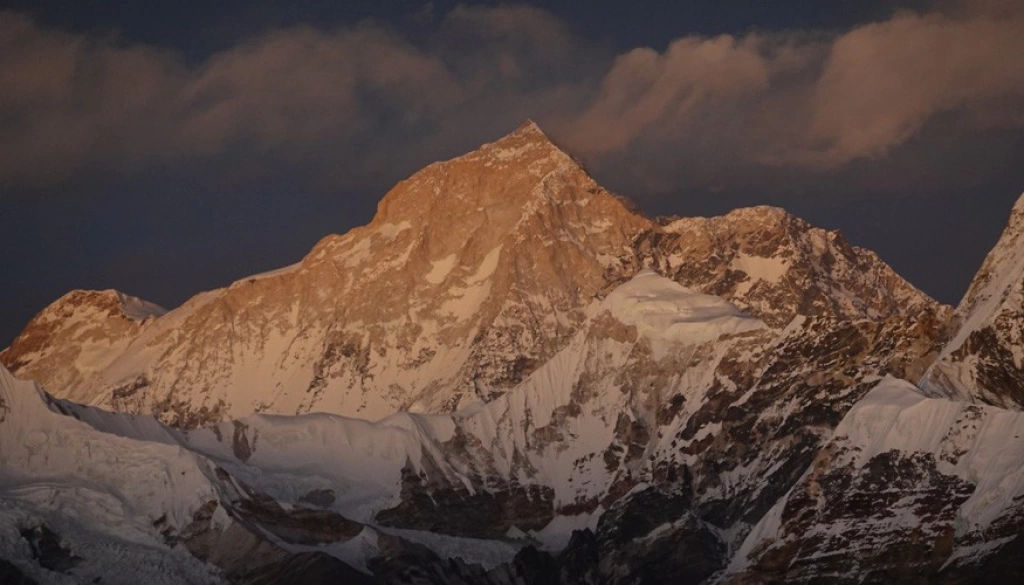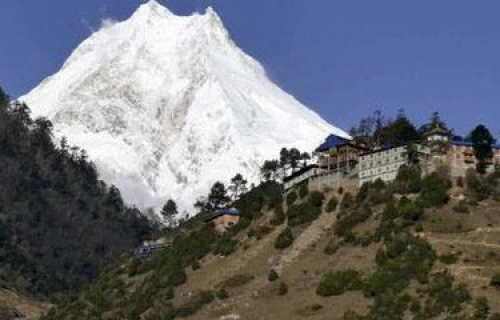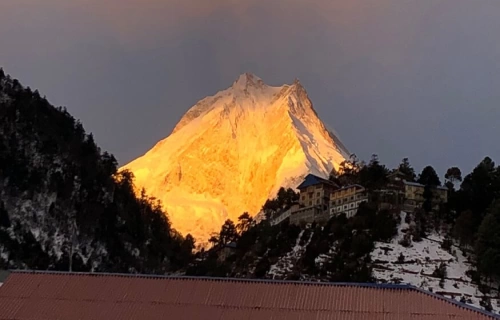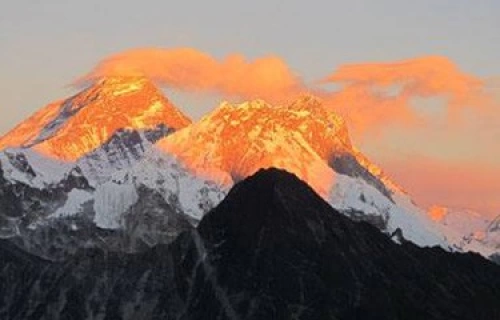About Makalu Expedition
Makalu, 8463m, should not be underestimated; this expedition is considered more challenging than many other 8000-meter peaks. Its steep pitches on rock and ice and highly exposed knife-edged ridges demand the physical and mental and technical competence of mountaineers with previous high-altitude experience. Since base camp is in such an isolated region, Makalu doesn't attract the crowds like the popular peaks of Everest, Cho Oyu, and Lhotse.This remoteness actually adds to the allure and excitement of this immense mountain. Recently plane/helicopter access has made the mountain much more accessible, avoiding the long and difficult trek into base camp. The few teams who attempt Makalu tend to be small and competent.
Makalu, fifth highest mountain in the world, lies approximately 20 km east of Everest with its summit ridge on the Nepali-Tibetan border. This magnificent 4-sided pyramid beckoned the mountaineers of early expeditions no Mt. Everest to come and climb. So, in 1955, only two years after the first ascent of Everest, a French team reached the summit of Makalu from the northeast ridge, which remains the standard route. Only five of the first sixteen attempts made on the mountain were successful. Up to Camp II the climb on glacier is fairly easy. There is steep ice and snow on the climb to the Makalu La. Above Camp IV, a final rock ridge to the summit.
- hand-picked Sherpas will provide full support all the way to the summit. Not only do our Sherpa mountaineering guides have many ascents of 8000-meter peaks to their credit, they are trained in mountain first aid and experienced in dealing with the symptoms of altitude related illness. Climbing with your own personal Sherpa guide allows you to go at your own pace and take advantage of a window of good weather.Your Sherpa will move ahead, fixing ropes, carrying loads of oxygen and supplies and setting up camps.
The trek into Makalu Base Camp starts after a short flight from Kathmandu to Tumlingtar, in the base of the Arun River Valley. The eleven-day camping trek to Makalu Base Camp is in itself an exciting trek through a remote and inaccessible region where few trekkers venture. This region falls within the Makalu Barun National Park and Conservation Area, famous for its outstanding natural beauty and diversity of flora and fauna.
The trek starts at just 400m altitudeand reaches 4800m in only ten days, passing through distinct vegetation zones from sub-tropical jungles, farmland and bamboo and rhododendron forests, to high alpine pastures. You will also observe the unique cultures of the Rai, Limbu and Newar ethnic groups which dominate the lower altitudes and the Sherpas of the higher regions.
At Kongma La, on the barren tree line, we get magnificent views of Kanchenjunga and Makalu. A steep ascent over rock boulders takes us up to the Shipton La Pass, 4229m from where we descend to Muga (Do Bato), the same altitude as Kongma La. Once again we cross the Arun River, and follow the deep gorge with juniper forest lining the walls on either side of us. The terrain becomes rocky with loose scree as we near Makalu Base Camp, 4800m. We stop for two nights to acclimatize and explore lovely high grazing areas at the tip of the Barun Glacier. There are breathtaking views of Everest 8850m, Lhotse 8516m, Makalu 8463m, Chamlang 7319m and Baruntse 7220m.
A quicker option to Makalu Base Camp:
Taking a helicopter to Makalu Base Camp saves time and allows us to immediately begin acclimatization and work on the mountain itself. Helicopter flights are available at the climbers own expense. The cost depends upon passenger load.
The Climb of Makalu via North East Ridge:
The Makalu Expedition begins Makalu Base Camp, 4800m and uses five camps above base camp during the expedition.
Typical Expedition Description:
After two or three days in Base Camp, organizing equipment and enjoying short walks in the valley, we make the 7 hour journey up the moraine and boulder fields of the Barun Glacier to Advanced Base Camp 5700m (ABC), perched on a rocky dome at the foot of Makalu’s glaciers. We rest and acclimatize at ABC, a sunny camp where we spend most of our time on Makalu, and where we enjoy the comforts of heated dining tents, kitchen tent, communications and hangout tent, internet access, and much more. Although sheltered from the wind and rock fall, it can be very cold.
From ABC the route covers a rocky moraine of the low-angle Chago Glacier. We put crampons on and rope up as the glacier is crevassed in places and there is some avalanche danger from falling seracs, though these can be avoided with good route choice. Just before reaching Camp I, 6347m, we ascend a steep ice-snow wall with fixed lines. On this first rotation we spend at least 2 nights in Camp I, and during that time make an acclimatization trip across easy glacier to Camp II, 6600m a small, flat sheltered area by some ice walls.
Our second acclimatization rotation stops for a night at Camp 1, and then continues in a north eastern direction across the huge crevasses and snow bridges of glacial slopes.There is a steeper section of blue ice below Camp II, 6670m.Our Sherpa will have fixed the ropes. From Camp II you get a fantastic view of Everest, Lhotse and Baruntse. We spend two or more nights to acclimatize, and during that time climb to at least 7000m on the steep slopes that leading to the Makalu La (Camp III). We descend to ABC for rest in preparation for our summit push.
Climb from ABC to Camp II
The climb from ABC directly to Camp II takes only about 6 hours once acclimatized.Camp II has fantastic views of Everest, Lhotse and Barunste.We probably rest a day before proceeding to Camp III, but our decision will depend on our physical state as well as the weather.
Climb to Camp III on the Makalu La
Above Camp II, an easy-angled glacier leads straight up to 6990m. Next, a technical section of mixed climbing to about 7250m, leads onto another open snow slope, which can be deep and prone to avalanches.There is one more mixed section of rock and blue ice leading up to the Makalu La at 7450m.To reach the site of Camp III, 7400m, there is 200 meters of flat walking.Some of the mixed climbing is up to an angle of 50 degrees.This is one of the most technical sections of the climb and we will appreciate that the Sherpa has carefully selected the route and put fixed lines in place. Remembering that we have to descend this difficult section, we try to carry the minimum to Camp III on the La.
The decision to ascend to the Makalu La requires careful consideration of the weather. Strong winds whip across the La, and temperatures can dip to -30 °C.
Note: We start using oxygen to make the long steep ascent to Camp III, 7400m, on the Makalu La. We will use supplemental oxygen for the rest of the summit push and return to Camp III.
Climb to Camp IV
From Camp III, it takes only 3 hours to climb to Camp IV, 7600m, the last feasible spot for a camp below the summit. We traverse a large, flat glacier, with many hidden crevasses, and then follow snow slopes to a serac band, protected from avalanches. At Camp IV, tent platforms are cut in the slope, on the North Face.
Summit Day
On summit day, we climb moderate glacial slopes to the base of the French Couloir, a shallow 300m high gully of mixed rock bands and snow that leads onto the summit ridge at around 8350m. We negotiate the summit towers along the extremely exposed ridge leading to the true but small summit of Makalu.This immense mountain has the smallest summit of all 8000-meter peaks.The summit view unparalleled: the panorama starts with Kanchenjunga in the east with a sea of peaks reaching to Shishapangma in the west.
Descent
Summit day is a very long and demanding day, often taking around 16 hours to reach the top and return back to Camp IV where we crash with exhaustion. Some climbers manage to descend to Camp III from the summit.
The next descent is demanding as we are exhausted, and must focus to abseil over the technical sections from Makalu La to Camp II, where we spend the night. We continue down to ABC to celebrate our climb, rest, and prepare for our return to Kathmandu.
Return from Expedition
The schedule allows seven days to trek back to Tumlingtar. We are accompanied by porters carrying our gear.
A quicker option back to Kathmandu:
At the end of a long expedition, a quick flight by helicopter from Base Camp to Kathmandu is quite appealing. Helicopter flights are available at the climbers own expense.The cost depends upon passenger load and whether the helicopter is already in the area or has to come from Kathmandu.



